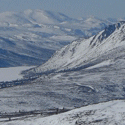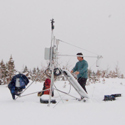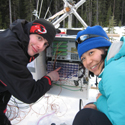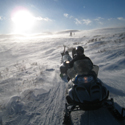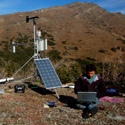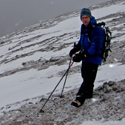|
Theme 1 - Processes
Theme Lead: Sean Carey, Carleton University
(e-mail, www)
The theme aims to improve understanding of the key physical processes
involved in the hydrometeorology of cold regions, through intensive and
extensive studies of the nature and characteristics of climate and weather, the cryosphere, land surface and sub-surface, water bodies and the biosphere,
in a group of high-latitude / high-altitude
research basins.
Observations made in each basin have been used to derive algorithms representing
a range of natural processes relevant to cold-regions hydrology.
Processes studied include sensible heat exchange, evaporation, radiation
exchange, snow accumulation and loss, blowing snow transport rate,
precipitation, snowmelt, ground heat flux, advection, soil thaw, overland flow,
sub-surface flow, soil moisture change, runoff and streamflow.
The characteristics and conditions found in different basins makes them more or
less useful for studying different processes, as shown in the table below;
| |
Trail Valley |
Havikpak Creek |
Wolf Creek |
Scotty Creek |
Baker Creek |
Peyto Creek |
Lake o'Hara |
Marmot Creek |
Snow
Redistribution |
 |
|
 |
|
|
 |
|
 |
Snow / ice melt
and runoff |
 |
 |
 |
|
|
 |
 |
 |
Lake runoff
|
 |
|
 |
|
 |
|
 |
|
Hillslope runoff
|
|
|
 |
 |
 |
|
 |
 |
Permafrost
dynamics |
 |
 |
 |
 |
|
|
|
|
Open-water
evaporation |
 |
|
|
|
 |
|
|
|
Evaporation and
energy-balance |
 |
 |
 |
 |
 |
 |
 |
 |
Issues of spatial variability in these processes have been
addressed by taking multiple observations within basins, and making comparison
between basins, supported by the use of new remote sensing technology. Because the basins cover
significantly different topography and climate, the algorithms have been evaluated to ensure robustness and transferability to a variety
of different environments.
Theme 1 Timeline:
2007
- Install and upgrade hydrometeorological network in research basins and
begin all field observations
- Explore alternative methods to LIDAR for obtaining high-resolution DEMs
for research basins
- Collation of historical processes data collected in MAGS and Quinton-CFCAS
project
- Begin analysis of MAGS historical turbulent and radiative transfer data
applicable to IP3 project
- Boundary layer growth experiment begins
- Identify existing LSS numerical process descriptions for cryosphere
processes and incorporate into CRHM
- All research sites fully instrumented and experiments set up
2008
- All field field-sites fully operational with personnel on-site for
intensive data collection
- Ongoing analysis of HRU runoff sources, pathways, residence times, and
intra-basin hydrological interaction
- Evaluate and upscale existing numerical process descriptions for frozen
and organic soils
- Ongoing analysis and of radiative and turbulent transfer data from lake
and snow experiments
- Implementation of new and developing numerical process descriptions into
CRHM
- Frequency distributions for spatial representation of soil parameters
determined
- New numerical routines to accurately estimate ground thaw and how it
relates to surface and vegetation properties
- DEMs obtained for each basin
2009
- Final year of full-scale field measurement programmes
- Milestones & Deliverables
- All primary data collection for Theme 1 objectives complete
- Analysis of aircraft flux and historical MAGS data complete
- Sources, residence times and pathways of water for intra-basin HRUs
resolved
- New basin runoff description linking hillslope processes and stream
routing complete
- Seasonal energy and water balance of arctic lakes determined
- Role of lakes in regional climate established and numerical descriptions
of lake advection for all stability conditions complete
- New algorithms for turbulent closure atop glaciers complete
- Numerical process descriptions of long-wave exitance from snow and
shortwave radiation transfer through canopies complete
- New bulk-transfer coefficients for snow determined
2010
- Incorporation of all new numerical process descriptions into CRHM complete
- Continued refinement of numerical process descriptions as they are tested
across all research catchments
|
Participants |
|
|
Sean Carey |
Carleton University |
|
Richard Essery |
University of Edinburgh, UK |
|
Raoul Granger |
Environment Canada |
|
Masaki Hayashi |
University of Calgary |
|
Richard Janowicz |
Yukon Environment |
|
Philip Marsh |
University of Saskatchewan |
|
Scott Munro |
University of Toronto |
|
John Pomeroy |
University of Saskatchewan |
|
William Quinton |
Wilfrid Laurier University |
|
Ken Snelgrove |
Memorial University of Newfoundland |
|
Ric Soulis |
University of Waterloo |
|
Chris Spence |
University of Saskatchewan |
|
Diana Verseghy |
University of Waterloo |
|










